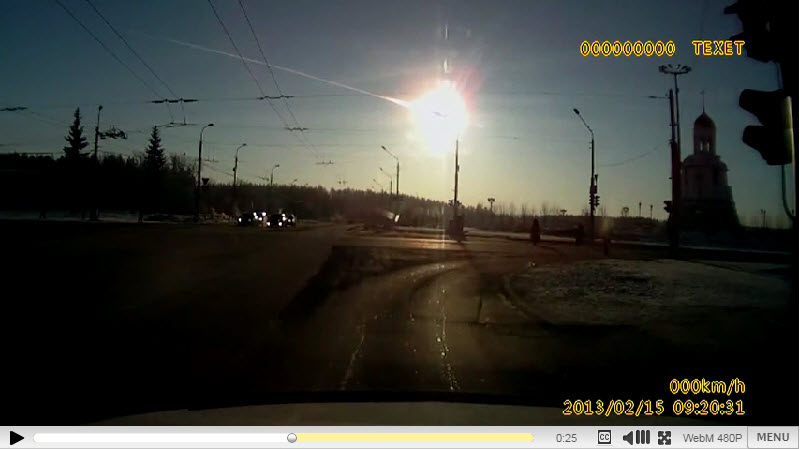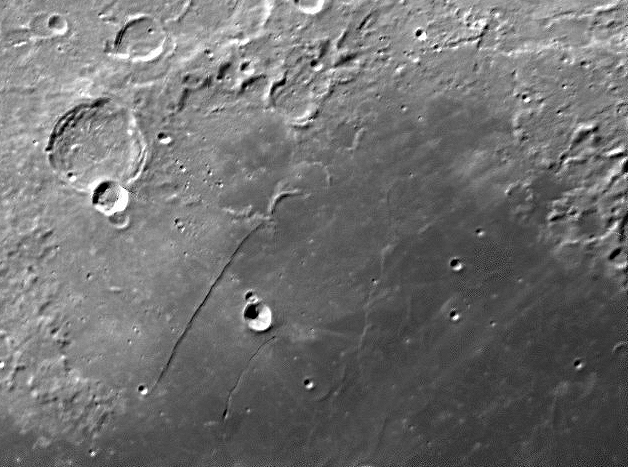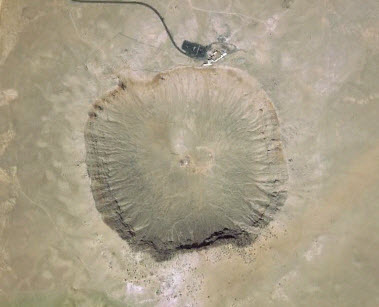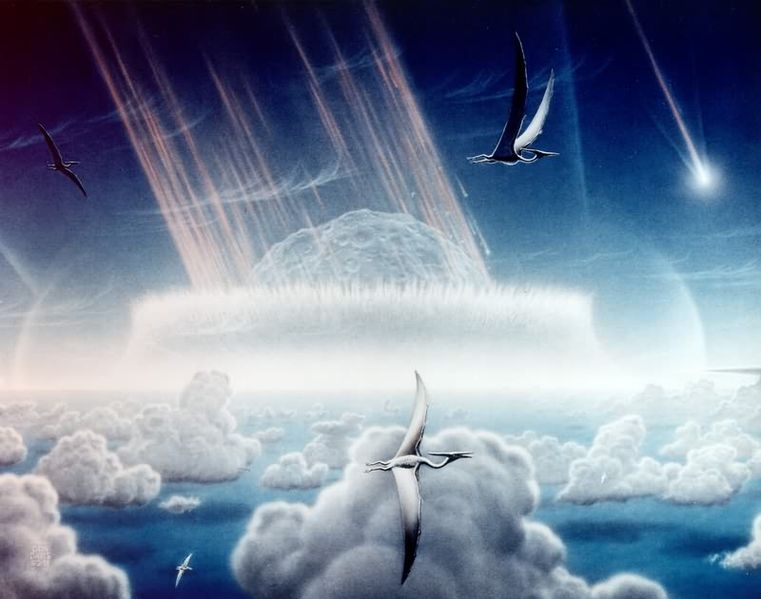Impacts on Earth
420-423
On warm sunny morning in June 30, 1908 (7:14 am) a meteor as bright as the sun sped across the Siberian sky. A few seconds later trees were flattened for thousands of square kilometers. As many as 50 000 caribou may have perished but there were no human casualties. The cause - probably a cometary chunk mostly consisting of ices (H2O and CO2 ) and measuring about 100 meters in diameter vaporized about 6 km above ground level. The resulting explosion was equivalent to a 10 MT blast. We can't see objects this small but tens of thousands of them must exist in the vicinity of earth and its orbit. This is the famed "Tunguska Event", named for the Tunguska River region of Siberia in which the fireball fell.
The Chelyabinsk EventOn the morning og February 15, 2013 a super-bolide entered the atosphere over the Russian city of Chelyabinsk. The asteroidal body was travelling at about 19 km/s and exploded mid-atmosphere with an effective energy of about 500 kilotons equivalent TNT or about 30 times the bomb that destroyed Hiroshima in 1945. Such events as this occur with about a 30 year frequency.
 |
|---|
| Link to video of the Chelyabinsk bolide exploding overhead on February 15, 2013. |
Events like these serve as a stark reminder that the Solar System is still a busy place and impact phenomena have and will in the future continue to shape the evolution of our planet.
Dinosaur Extinction and Possible Causes
In many ways the dinosaurs represent a very successful biological group. Paleontologists tell us that they dominated the earth for many millions of years and then in an exceedingly short period of time vanished. Why would a seemingly thriving and dominant life form just "die"? Many answers to this riddle have been offered. Some of the more popular theories have been:
- disease
- volcanoes
- supernovae
- asteroidal or cometary impact
It is now generally accepted that it is the last of these - asteroidal or cometary impact that explains the demise of the dinosaurs..
A Father and Son Coup
Luis Alvarez - a nobel prize winning physicist and his son Walter published a fascinating paper in 1980. In this paper they show that certain geological rock strata (layers) throughout the world have a very peculiar over abundance (by about 160 times!!) of the scarce element iridium . The iridium enrichment occurs consistently at a depth that corresponds to the era during which the dinosaurs became extinct. On average the fossil record reveals dinosaur fossils below this layer but very few above the layer. This defines a prehistoric boundary called the Cretacious-Tertiary boundary which geologists tell us represents an epoch about 65 million years ago.
 |
Figure 19.22 Illustration showing a thin layer of iridium enriched material at the K-T boundary - deposited about 65 million years ago. |
The Alvarez's discovery raises the following fascinating possibility: Meteoritic samples collected on earth show very high iridium abundances. Perhaps the iridium found at the Cretacious-Tertiary boundary is the result of the dispersal of a very large meteor (comet or asteroid) that slammed into the earth about 65 million years ago. The subsequent plume of dust and debris that was thrown up formed a dense cloud that obscured the sun for more than a year. This led to severe cooling, failure of vegetation and the dinosaurs - along with 90% of the earth's biomass perished.
 |
| Figure 19.23 Badlands near Drumheller, Alberta, where erosion has exposed the KT boundary. (public domain image credit Glen Larson) |
Figure 19.23 shows the KT boundary exposed by erosion in the badlands near Drumheller, Alberta.
Looking for Evidence
Look at the moon. The heavily cratered surface tells us that our nearest neighbour has suffered numerous impacts over its 4.5 billion year history. It seems likely that the same could be said for the earth. The lunar highlands are heavily cratered and reveal that at a very early epoch the moon was subject to very intense bombardment by objects ranging up to 10's to 100's of km in diameter. These craters are old and were formed very early in the earth-moon history. The lunar maria, on the other hand are large lava flows that formed later and it is the craters situated in them that are most revealing. Apollo rock samples brought back from the moon reveal that the lunar maria are about 3.5 billion years old. Craters found in the maria would have formed after this. Figure 19.24 shows a part of Mare Nubium with a mixture of crater sizes and ages. By doing some very simple math we can learn a lot - by inference - about the earth.
|
 |
| Figure 19.24 Mare Nubium region of the moon.. The straight wall (Rupes Recta) formed from a collapsed lava channel which formed after the lunar sea "flooded" with lava. Click on image to enlarge in pop-up window. (Image courtesy The King's University College Observatory) |
Meteor Crater
| Any trip through Arizona should include a stop at Meteor Crater! This gives you a chance to explore - first hand - a relatively recent cataclysmic event in Earth's history. We believe that this event took place about 50 000 years ago. Such an event today would devastate North America! |  |
|---|---|
| Figure 19.24b Aerial view of Meteor Crater - a 50 000 year old reminder that major impact events occur on Earth! |
slide show of the Barringer (aka Meteor) crater 
Build Your Own Crater?
Figure 19.25 provides you with the applet Crater Calculator that enables you to see just how much "explosive punch" even a small chunk of asteroidal material can pack.| Figure 19.25 |
Example 19.7 In 1998 media reports buzzed with the discovery that a "mile wide" asteroid (1997 FX11) could be on a collision course with Earth in 2028. Estimate the energy and possible size of crater this impact could produce.
.Solution: Use the applet Crater Calculator. You will need to make some assumptions. Is it a C or M type asteroid? Let's choose M-type, so assign the asteroid a density comparable to Iron-Nickel or 8000 kg/m3. Next, assign an impact velocity. Pick a velocity comparable to Earth's orbital velocity - so let it be moving at 25 km/s |
 |
| Assume it impacts at 90 degrees to the horizon. Set the diameter as 1600 m ("mile wide"). A screen capture of the output from Crater Calculator is shown in the panel above. This would be an enormous and devastating impact and create a crater nearly 20 km wide and almost 5 km deep! | |
If the answer to example 19.7 worries you, you will be relieved to learn that subsequent observations of 1997FX11 show that it will in fact miss the Earth by 600 000 km when it passes by in 2028!
The Chicxulub Crater - A Possible Candidate for Dinosaur Extinction
In the late 1970's the geologist Glen Penfield was looking for oil off the Yucatan peninsula when he discovered an unusual crater whose centre is near the town of Chicxulub, Mexico. Follow-up work with Dr. Alan Hildebrand (now at University of Calgary) suggest strongly that this is an impact crater produced by collision with an asteroid.
The crater is more than 180 km across and is now accepted as the site of the event that produced the iridium enriched K-T boundary discovered by the Alvarez's in the 1980s. This crater is believed to be the 65 million year old.
 |
| Figure 19.26 Artist Don Davis depicts the asteroid impact creating the Chixulub Crater, 65 million years ago. (Image produced for NASA - in public domain) |
"smoking gun" that explains why the dinosaurs became extinct. Figure 19.26 shows an artist's impression of the impact event.
How Big is Big?
How big would a meteor have to be to create a major crater? Detailed calculations and experimental tests reveal about a 10 times relationship between crater and impacting object. To form a 100 km diameter crater would require an object about 10 km across. Such an impact would occur at a speed of about 50 km/s. It would release the equivalent of about 10 trillion tons of TNT (1 million 10 MT H bombs!!!). If only 1 percent of the impacting body was thrown into the atmosphere as dust it would blanket the earth with a dense layer of fine iridium enriched dust several cm thick just like the layer found by the Alvarez's.
Catastrophism
The fact that Earth is subject to ongoing collisions with asteroids or comets is well supported by the evidence. It also leads to a troubling conclusion
another major impact is certain!
Whether it will occur tomorrow or ten million years from now is unknown. What is clear, however, is that cataclysmic events do occur. The recognition that global change can sometimes be violent and sudden has spawned a new concept in science - catastrophism . We can no longer presume that change occurs only over long, gradual time scales. To see a list of known impact craters "Take a Closer Look?
Practice
-
Use Google-Earth© to locate the following craters and comment on what you see. You will notice that some may not be visible at all. How do we know that they are there? (Hint - think about how compositional differences in meteorites could enable detection).
Name Latitude Longitude Diameter
(km)Age
(Ma)Acraman, Australia 32°1'S 135°27'E 160.000 570.00 Barringer, Arizona, USA 35°2'N 111°1'W 1.186 0.049 Carswell, Saskatchewan, Canada 58°27'N 109°30'W 39.000 115.00 ± 10.00 Eagle Butte, Alberta, Canada 49°42'N 110°35'W 19.000 65.00 Manicouagan, Quebec, Canada 51°23'N 68°42'W 100.000 212.00 ± 1.00 (to locate these in GoogleEarth just type the coordinates in for the location, for example type 32S,135E to roughly locate the Acraman crater in Australia. Then zoom in to the exact location.)
- How would the impact event that produced the Manicougan crater in Quebec compare with the Chicxulub event in the Yucatan that produced the mass extinction 65 million years ago?
- Inspect the table of known terrestrial impact sites provided in the "Take a Closer Look". Would you expect that there have been other mass extinction events in the past 500 million years which is the time frame roughly corresponding to the emergence of life more complex than single cells?
- By inspecting the data in the table used in question 3 try to estimate how frequently events producing craters bigger than 150 km across occur.
- If mass extinction events are very rare why should we "care"?

Chp 19-4